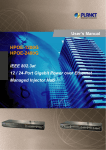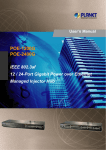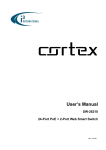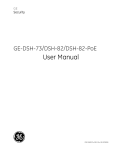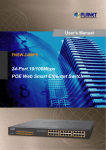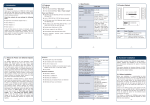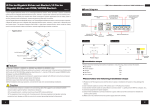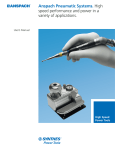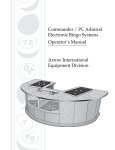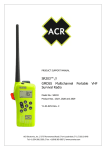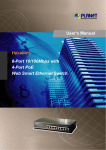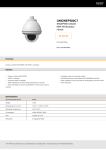Download User Manual - Planetechusa.com
Transcript
User’s Manual 12/24-Port 802.3at PoE Injector Hub HPOE-1200G / HPOE-2400G www.PLANET.com.tw User’s Manual of HPOE-1200G / HPOE2400G Trademarks Copyright © PLANET Technology Corp. 2013. Contents are subject to revision without prior notice. PLANET is a registered trademark of PLANET Technology Corp. All other trademarks belong to their respective owners. Disclaimer PLANET Technology does not warrant that the hardware will work properly in all environments and applications, and makes no warranty and representation, either implied or expressed, with respect to the quality, performance, merchantability, or fitness for a particular purpose. PLANET has made every effort to ensure that this User's Manual is accurate; PLANET disclaims liability for any inaccuracies or omissions that may have occurred. Information in this User's Manual is subject to change without notice and does not represent a commitment on the part of PLANET. PLANET assumes no responsibility for any inaccuracies that may be contained in this User's Manual. PLANET makes no commitment to update or keep current the information in this User's Manual, and reserves the right to make improvements to this User's Manual and/or to the products described in this User's Manual, at any time without notice. If you find information in this manual that is incorrect, misleading, or incomplete, we would appreciate your comments and suggestions. FCC Warning This equipment has been tested and found to comply with the limits for a Class A digital device, pursuant to Part 15 of the FCC Rules. These limits are designed to provide reasonable protection against harmful interference when the equipment is operated in a commercial environment. This equipment generates, uses, and can radiate radio frequency energy and, if not installed and used in accordance with the Instruction manual, may cause harmful interference to radio communications. Operation of this equipment in a residential area is likely to cause harmful interference in which case the user will be required to correct the interference at his own expense. CE Mark Warning This is a Class A product. In a domestic environment, this product may cause radio interference, in which case the user may be required to take adequate measures. Energy Saving Note of the Device This power required device does not support Standby mode operation. For energy saving, please remove the power cable to disconnect the device from the power circuit. In view of saving the energy and reducing the unnecessary power consumption, it is strongly suggested to remove the power connection for the device if this device is not intended to be active. WEEE Warning To avoid the potential effects on the environment and human health as a result of the presence of hazardous substances in electrical and electronic equipment, end users of electrical and electronic equipment should understand the meaning of the crossed-out wheeled bin symbol. Do not dispose of WEEE as unsorted municipal waste and have to collect such WEEE separately. Revision PLANET IEEE 802.3at Power over Gigabit Ethernet Managed Injector Hub User's Manual FOR MODELS: HPOE-1200G / HPOE-2400G REVISION: 2.0 (JUNE.2013) Part No.: 2080-AF0270-002 2 User’s Manual of HPOE-1200G / HPOE2400G TABLE OF CONTENTS 1. INTRODUCTION .............................................................................................................5 1.1 PACKAGE CONTENTS .................................................................................................................................. 5 1.2 PRODUCT DESCRIPTION .............................................................................................................................. 5 1.3 HOW TO USE THIS MANUAL ........................................................................................................................ 7 1.4 PRODUCT FEATURES .................................................................................................................................. 8 1.5 PRODUCT SPECIFICATIONS ....................................................................................................................... 10 2. INSTALLATION ............................................................................................................12 2.1 HARDWARE DESCRIPTION ......................................................................................................................... 12 2.1.1 Injector Front Panel.......................................................................................................................... 12 2.1.2 LED Indicators.................................................................................................................................. 13 2.1.3 Injector Rear Panel .......................................................................................................................... 13 2.2 INSTALLING THE POE INJECTOR HUB......................................................................................................... 14 2.2.1 Desktop Installation.......................................................................................................................... 14 2.2.2 Rack Mounting ................................................................................................................................. 14 2.2.3 Network Application Installation ....................................................................................................... 16 2.2.4 Power over Ethernet Powered Device ............................................................................................. 17 3 Management..................................................................................................................18 3.1 OVERVIEW ................................................................................................................................................ 18 3.2 REQUIREMENTS ........................................................................................................................................ 18 3.3 MANAGEMENT METHOD ............................................................................................................................ 19 3.3.1 Web Management............................................................................................................................ 19 3.3.2 PLANET Smart Discovery Utility...................................................................................................... 20 4 WEB CONFIGURATION ................................................................................................22 4.1 MANIN MENU ............................................................................................................................................ 22 4.2 WEB PANEL ............................................................................................................................................. 23 4.3 SYSTEM ................................................................................................................................................... 23 4.3.1 System Information .......................................................................................................................... 24 4.3.2 IP Configuration ............................................................................................................................... 25 4.3.3 NTP Configuration............................................................................................................................ 26 4.3.4 Password Setting ............................................................................................................................. 27 4.3.5 Firmware Upgrade ........................................................................................................................... 28 4.3.6 Configuration Setting........................................................................................................................ 29 4.3.7 Factory Default................................................................................................................................. 32 4.3.8 System Log ...................................................................................................................................... 34 4.3.9 System Reboot................................................................................................................................. 35 4.3.10 Logout ............................................................................................................................................ 35 4.4 SNMP ..................................................................................................................................................... 37 3 User’s Manual of HPOE-1200G / HPOE2400G 4.4.1 SNMP Management......................................................................................................................... 37 4.5 POWER OVER ETHERNET........................................................................................................................... 39 4.5.1 PoE Configuration ............................................................................................................................ 40 4.5.2 PoE Schedule profile........................................................................................................................ 42 4.5.3 PoE Schedule .................................................................................................................................. 44 4.5.4 PoE Schedule Profile configuration example................................................................................... 45 4.5.5 PoE Alive Check Configuration........................................................................................................ 49 5. Power over Ethernet Overview ...................................................................................51 6. PoE Provision Process................................................................................................53 6.1 LINE DETECTION ....................................................................................................................................... 53 6.2 CLASSIFICATION ....................................................................................................................................... 53 6.3 START-UP ................................................................................................................................................ 54 6.4 OPERATION .............................................................................................................................................. 54 6.5 POWER DISCONNECTION SCENARIOS ........................................................................................................ 54 APPENDIX A.....................................................................................................................56 A.1 MDI SETTINGS ......................................................................................................................................... 56 A.2 POWER DEVICE CLASSIFICATION VALUES.................................................................................................. 56 A.3 DATA OUT POE INJECTOR RJ-45 PORT PIN ASSIGNMENTS .................................................................... 57 4 User’s Manual of HPOE-1200G / HPOE2400G 1. INTRODUCTION 1.1 Package Contents CHECK THE CONTENTS OF YOUR PACKAGE FOR THE FOLLOWING PARTS: ● PoE Injector Hub x 1 ● Quick Installation Guide x 1 ● User’s Manual CD x 1 ● Power Cord x 1 ● Rubber Feet x 4 ● Two Rack-mounting Brackets with Attachment Screw x 1 (set) If any of these are missing or damaged, please contact your dealer immediately; if possible, retain the carton including the original packing material, and use them again to repack the product in case there is a need to return it to us for repair. In the following section, the term “PoE Injector Hub” means the two Gigabit PoE Injector Hub devices, i.e. HPOE-1200G and HPOE-2400G. The term “injector” means any IEEE 802.3at / 802.3af power injectors. “PD” means IEEE 802.3at / 802.3af powered device. 1.2 Product Description The PoE Injector Hub is a 12- / 24-port IEEE 802.3at / 802.3af Power over Ethernet Mid-Span injector hub which complies with IEEE 802.3, IEEE 802.3u, IEEE 802.3ab, IEEE 802.3at and IEEE 802.3af standards. It is equipped with 12 / 24 10/100/1000Mbps Gigabit Ethernet ports that support full 52V DC power for any remote IEEE 802.3at / 802.3af powered device (PD) like 802.11b/g/n wireless LAN access point, IP phone, LAN camera or any other network device. The PoE Injector Hub should provide sufficient 30.8-/15.4-watt power per port to the 12 / 24 remote PD devices with 360-/720-watt power supply. The PoE Injector Hub is installed between a regular Ethernet switch and the powered devices, injecting power without affecting the data transmission. It offers a cost-effective solution and quick way to upgrade the network system to IEEE 802.3at / 802.3af Power over Ethernet, without replacing the existing Ethernet Switch. There are 24 / 48 RJ-45 STP ports on the front panel of PoE Injector Hub, of which 12 / 24 of them on the lower stack are "Data" ports and the other 12 / 24 ports on the upper stack are "Data + Power output" ports. Each of the "Data + Power output" ports on upper stack functions act as an injector which inserts DC Voltage into the CAT 5e/6 cable allowing the cable between the Injector and Splitter to transfer data and power simultaneously. To manage your powered devices, the PoE Injector Hub provides both Web management interfaces in which administrators can manage functions such as port Enable/Disable, port priority, limit, schedule, system configuration, change of Username/Password and smart feature for powered device. The PoE Injector Hub can auto-detect the power status on each port and show messages of Web management interface. These features also provide a cost-effective way to manage the devices from Internet whenever you are at work or at home. 5 User’s Manual of HPOE-1200G / HPOE2400G Power over Ethernet Applications For the places hard to find the power outlet, the PoE Injector Hub provides the easiest way to power your Ethernet devices such as PLANET Internet cameras and outdoor wireless access point installed on the top of the building. To control the power system of your networking devices, the Gigabit PoE Injector Hub can directly co-work with PoE IP Phone to build VoIP telephony network in the office. Furthermore, the Gigabit PoE Injector Hub can be directly connected to any third party 802.3at / 802.3af devices and PoE switches installed 100 meters away. Manager Area Office Building Office Area Management PC Speed Dome N IEEE 802.3af PoE Wireless AP PoE 720Watts PoE Power Budget DC PoE IEEE 802.3at PoE Splitter IEEE 802.3af PoE VoIP Phone HPOE-2400G PoE PoE IEEE 802.3at PoE IP Camera 24-Port Gigabit Switch PoE PoE IEEE 802.3af PoE IP Camera PoE Control Room DC IEEE 802.3af PoE IP Camera PoE Extender IEEE 802.3af PoE Splitter Office Building IP Camera Warehouse DC Power Line (DC) 1000Base-T UTP Figure 1: PoE Injector Hub Application 6 1000Base-T UTP with PoE PoE 100Base-TX UTP N 2.4GHz 802.11n User’s Manual of HPOE-1200G / HPOE2400G 1.3 How to Use This Manual This User Manual is structured as follows: Section 2, Installation It explains the functions of PoE Injector Hub and how to physically install the PoE Injector Hub. Section 3, Management It contains information about the software function of the PoE Injector Hub. Section 4, Web Configuration The section explains how to manage the PoE Injector Hub through Web interface. Section 5, Power over Ethernet overview The section explains the Power over Ethernet theories. Section 6, PoE power Provision Process The section explains the PoE power provision process. Section 7, Troubleshooting The section contains troubleshooting guide of the PoE Injector Hub. Appendix A It contains cable information of PoE Injector Hub. 7 User’s Manual of HPOE-1200G / HPOE2400G 1.4 Product Features Physical Port HPOE-1200G 24-Port RJ-45 12 -Port 10/100/1000Mbps “Data input” 12 -Port 10/100/1000Mbps “Data + Power output” 1-Port 10/100Base-TX Management Port Reset button for system management HPOE-2400G 48-Port RJ-45 24 -Port 10/100/1000Mbps “Data input” 24 -Port 10/100/1000Mbps “Data + Power output” 1-Port 10/100Base-TX Management Port Reset button for system management Power over Ethernet Complies with IEEE 802.3, IEEE 802.3at and IEEE 802.3af Power over Ethernet Mid-Span PSE Up to 24 IEEE 802.3at / 802.3af devices powered Supports PoE power up to 30.8 watts / 15.4 watts for each PoE port Automatically detects powered device (PD) Circuit protection prevents power interference between ports Remote power feeding up to 100m PoE Management Total PoE power budget control Per port PoE power schedule Schedule Power Recycle PoE function enable / disable Per port PoE function enable / disable Per port 802.3at / 802.3af mode switch PoE port power feeding priority Per PoE port power limit PD classification detection PD alive check function Over temperature protection PoE temperature threshold PoE power usage threshold Management Web interface for remote management Supports Network Time Protocol (NTP) Firmware upgrade through Web interface PLANET Smart Discovery utility automatically finds PLANET devices on the network SNMP Trap for alarm notification of events System Log / Remote Syslog 8 User’s Manual of HPOE-1200G / HPOE2400G Hardware 19-inch rack mountable; 1U height Reset button for reset to default setting and system reboot LED indicators for PoE ready and PoE activity LED indicators for Power Alert and Fan Alert FCC Part 15 Class A, CE Standard Compliance IEEE 802.3 10Base-T IEEE 802.3u 100Base-TX IEEE 802.3ab 1000Base-T IEEE 802.3at High Power over Ethernet IEEE 802.3af Power over Ethernet 9 User’s Manual of HPOE-1200G / HPOE2400G 1.5 Product Specifications Product HPOE-1200G HPOE-2400G 12 x RJ-45 24 x RJ-45 12 x RJ-45 24 x RJ-45 Hardware “Data” Input Ports Interface “Data+Power” Output Ports Management Port 1 x RJ-45; 10/100Base-TX, auto-negotiation, auto-MDI / MDIX 10/100/1000Mbps Data Rate System: SYS Power x 1 (Green) LED System: SYS Power x 1 (Green) Management Port x 2: 10/100 Management Port x 2: 10/100 (Green / Orange) (Green / Orange) Per PoE Port: PoE in use x 1 Per PoE Port: PoE in use x 1 (Green) (Green) PoE1 Fail x 1 PoE Fail x 1 PoE2 Fail x 1 FAN Fail x 1 FAN1 Fail x 1 FAN2 Fail x 1 10Base-T: 4-Pair UTP Cat. 5 up to 100m (328ft) Network Cable 100Base-TX: 4-Pair UTP Cat. 5 up to 100m (328ft) 1000Base-T: 4-Pair UTP Cat. 5e, 6, up to 100m (328ft) EIA/TIA- 568 100-ohm STP (100m) 440 x 300 x 44 mm (1U height) Dimensions (W x D x H) Weight 4.18kg 4.76kg 100-240V AC, 50/60 Hz Power Requirements Power Consumption 440 Watts max. 0 ~ 50 degrees C Operating Temperature -10 ~ 70 degrees C Storage Temperature 5 ~ 95% (Non-condensing) Humidity Cooling 800 Watts max. Fan x 2 Fan x 3 Power over Ethernet Mid-Span PoE Power Supply Type Per Port DC 52V 30.8 / 15.4 watts PoE Power Output 4/5(-), 7/8(+) Power Pin Assignment PoE Power Budget 360 watts 720 watts 12 24 12 24 12 24 Number of 802.3af PD Class 0, 1, 2, 3 can be powered Number of 802.3at PD Class 1, 2, 3 can be powered Number of 802.3at PD Class 0, 4 can be powered Management Web, PLANET Smart Discovery Lite Management Interface Power Limit by Priority and Total Limit Per port power schedule Schedule Power Recycle PoE Management Per port power enable/disable Power feeding priority 10 User’s Manual of HPOE-1200G / HPOE2400G Current usage and status Total power consumption System / Management functions setup Web firmware upgrade Management Feature SNMP Trap for alarm notification of events Standards Conformance IEEE 802.3 10Base-T Ethernet IEEE 802.3u 100Base-TX Fast Ethernet Standards Compliance IEEE 802.3ab 1000Base-T Gigabit Ethernet IEEE 802.3at High Power over Ethernet IEEE 802.3af Power over Ethernet FCC Part 15 Class A, CE Regulation Compliance 11 User’s Manual of HPOE-1200G / HPOE2400G 2. INSTALLATION This section describes the hardware features and installation of these PoE Injector Hubs on the desktop or rack mount. For easier management and control of the PoE Injector Hub, familiarize yourself with its display indicators, and ports. Front panel illustrations in this chapter display the unit LED indicators. Before deploying the PoE Injector Hub, please read this chapter completely. 2.1 Hardware Description The section describes the hardware of the PoE Injector Hub and gives a physical and functional overview. 2.1.1 Injector Front Panel The unit front panel provides a simple interface monitoring the PoE Injector Hub. Figure 2-1-1 & 2-1-2 show front panel of the PoE Injector Hub. Front Panel of HPOE-1200G Figure 2-1-1: HPOE-1200G front panel Front Panel of HPOE-2400G Figure 2-1-2: HPOE-2400G front panel ■ Reset button At the left of the front panel, the reset button is designed for rebooting the PoE Injector Hub without turning off and on the power. Hardware Reset Button Figure 2-1-3: Reset Button of PoE Injector Hub 12 User’s Manual of HPOE-1200G / HPOE2400G The following is the summary table of Reset button functions: Reset Button Pressed and Released About 1 second Function Reboot the PoE Injector Hub. Reset the PoE Injector Hub to Factory Default configuration. About 8 seconds The PoE Injector Hub will reboot and load the default IP settings as shown below. Be sure that you back up the current configuration of PoE Injector Hub before resetting PoE Injector Hub or else the entire configuration will be erased when pressing the “RESET” button. 2.1.2 LED Indicators The front panel LEDs indicates instant status of system power, Management port Link/Active and PoE port links, helps administrator to monitor and troubleshoot when needed. LED Color Function FAN1 Failed Green Lights to indicate FAN1 has stopped. FAN2 Failed Green Lights to indicate FAN2 has stopped. (Only for HPOE-2400G) Power1 Failed Green Lights to indicate power supply 1 has failed. Power2 Failed Green Lights to indicate power supply 2 has failed. (Only for HPOE-2400G) Power Green Lights to indicate power on. PoE In-use Green Lights to indicate that the port is in use and supplying 48V DC power. 2.1.3 Injector Rear Panel The rear panel of the PoE Injector Hub indicates an AC inlet power socket, which accepts input power from 100 to 240V AC, 50/60Hz. Figures 2-1-4 & 2-1-5 show rear panel of the PoE Injector Hub. Figure 2-1-4: HPOE-1200G Rear Panel Figure 2-1-5: HPOE-2400G Rear Panel 13 User’s Manual of HPOE-1200G / HPOE2400G The PoE Injector Hub is a power-required device, meaning PoE Injector Hub will not work till it is powered. If your networks should be active all the time, please consider using UPS (Uninterrupted Power Supply) for your device. It will prevent you from network data loss or network downtime. In some area, installing a surge suppression device may also help to protect your device from being damaged by unregulated surge or current to the PoE Injector Hub or the power adapter. 2.2 Installing the PoE Injector Hub This section describes how to install your PoE Injector Hub and make connections to the PoE Injector Hub. Please read the following topics and perform the procedures in the order being presented. PLANET PoE Injector Hub does not need software configuration. 2.2.1 Desktop Installation To install a PoE Injector Hub on a desktop or shelf, simply complete the following steps: Step 1: Attach the rubber feet to the recessed areas on the bottom of the PoE Injector Hub. Step 2: Place the PoE Injector Hub on a desktop or shelf near an AC power source. Step 3: Keep enough ventilation space between the PoE Injector Hub and the surrounding objects. When choosing a location, please keep in mind the environmental restrictions discussed in Chapter 1, Section 5, under Specifications. Step 4: Connect your PoE Injector Hub to network 802.3at / 802.3af powered devices (PD) and Switch. A. Connect one end of a standard network cable to the upper stack 10/100/1000 RJ-45 ports on the front of the PoE Injector Hub. B. Connect the other end of the cable to the 802.3at / 802.3af powered devices (PD) such as IP phone, wireless access point, IP camera, splitter, or switch etc. C. Connect one end of a standard network cable to the relative lower stack 10/100/1000 RJ-45 port on the front of the PoE Injector Hub. D. Connect the other end of the cable to the port of Switch. Connecting to the PoE Injector Hub requires UTP Category 5e/6 network cabling with RJ-45 tips. For more information, please see the Cabling Specification in Appendix A. Step 5: Supply Power to the PoE Injector Hub. A. Connect one end of the power cable to the PoE Injector Hub. B. Connect the power plug of the power cable to a standard wall outlet. When the PoE Injector Hub receives power, the Power LED should remain solid Green. 2.2.2 Rack Mounting To install the PoE Injector Hub in a 19-inch standard rack, follow the instructions described below. Step 1: Place your PoE Injector Hub on a hard flat surface, with the front panel positioned towards your front side. 14 User’s Manual of HPOE-1200G / HPOE2400G Step 2: Attach a rack-mount bracket to each side of the PoE Injector Hub with supplied screws attached to the package. Figure 2-2-1 shows how to attach brackets to one side of the PoE Injector Hub. Figure 2-2-1: Brackets attaching to the PoE Injector Hub You must use the screws supplied with the mounting brackets. Damage caused to the parts by using incorrect screws would invalidate the warranty. Step 3: Secure the brackets tightly. Step 4: Follow the same steps to attach the second bracket to the opposite side. Step 5: After the brackets are attached to the Injector, use suitable screws to securely attach the brackets to the rack, as shown in Figure 2-2-2. Figure 2-2-2: Mounting the PoE Injector Hub in a Rack Step 6: Proceeds with steps 4 and 5 of session 2.2.1 Desktop Installation to connect the network cabling and supply power to your PoE Injector Hub. 15 User’s Manual of HPOE-1200G / HPOE2400G 2.2.3 Network Application Installation The PoE Injector Hub is not an equipment with data switching function between data ports. To inject PoE power and transmit data packets to PDs, the PoE Injector Hub is usually linked to an Ethernet switch. Typically, the Mid-Span Injector is installed between regular Ethernet switch and PDs, and mostly it is located close to the Ethernet switch side. To install a PoE Injector Hub on a network environment, simply complete the following steps: Step 1: Power on the PoE Injector Hub and connect the RJ-45 cable from the “Data” port to the Ethernet switch port. Step 2: Connect the RJ-45 cable from the “Data + Power” ports to the PDs, such as VoIP phone, IP camera. Step 3: Check the link status on both PD and Ethernet switch. Once the Injector starts to deliver 52V power over RJ-45 cables to PDs, the PoE In-Use LED of the PoE Injector Hub lights up. Figure 2-2-3: Network application installation The PoE Injector Hub supports Data passive mode, that is, even the PoE Injector Hub is manually power off, the data between “DATA” port and “DATA & PWR” port can still be transmitted without data loss. 16 User’s Manual of HPOE-1200G / HPOE2400G 2.2.4 Power over Ethernet Powered Device Voice over IP phones Enterprise can install POE VoIP Phone, ATA and other Ethernet/non-Ethernet end-devices to the central where UPS is installed for un-interruptible power system 3~5 Watts and power control system. Wireless LAN Access Points Access Points can be installed in any location of Museum, Tourist Site, Airport, Hotel, 6~12 Watts Campus, Factory, Warehouse, etc. IP Surveillance IP cameras can be installed anywhere in Enterprise, Museum, Campus, Hospital, 10~12 Watts Bank, etc. without the need of AC sockets. PoE Splitter PoE Splitter splits PoE 52V DC over the Ethernet cable into 5/9/12V DC power output. 3~12 Watts It frees the device deployment from restrictions due to power outlet locations, which eliminate the costs for additional AC wiring and reduces the installation time. High Power PoE Splitter High PoE Splitter splits PoE 52V DC over the Ethernet cable into 5/9/12V DC power 3~25 Watts output. It frees the device deployment from restrictions due to power outlet locations, which eliminate the costs for additional AC wiring and reduces the installation time. 17 User’s Manual of HPOE-1200G / HPOE2400G 3 MANAGEMENT This chapter describes how to manage the PoE Injector Hub with the following topics included: - Overview - Management Method - Logging on to the PoE injector Hub 3.1 Overview The PoE injector Hub provides a user-friendly, Web interface where you can perform various device configuration and management activities, including: System Power over Ethernet Tools 3.2 Requirements ■ Network cables. Use standard network (UTP) cables with RJ45 connectors. ■ Subscriber PC is installed with Ethernet NIC (Network Card) ■ Workstations run Windows 98/ME, NT4.0, 2000/2003/XP, MAC OS X or later, Linux, UNIX or other platforms compatible with TCP/IP protocols. ■ The above PC is installed with WEB Browser and JAVA runtime environment Plug-in It is recommended to use Internet Explore 7.0 or above to access the PoE Injector Hub. 18 User’s Manual of HPOE-1200G / HPOE2400G 3.3 Management Method User can manage the PoE injector Hub by Web Management via a network connection. 3.3.1 Web Management The PoE Injector Hub can be configured through an Ethernet connection. The factory default IP address is 192.168.0.100 with subnet mask 255.255.255.0, so please make sure the manager PC must be set on the same IP subnet address. For example, if POE Injector Hub IP address is set to factory default, then your manager PC should be set at 192.168.0.x (where x is a number between 1 and 254, except 100) with a subnet mask of 255.255.255.0. 1. Use Internet Explorer 7.0 or above Web browser. Enter IP address http://192.168.0.100 to access the Web interface. Figure 3-1-1: Web Management over Ethernet 2. When the following login screen appears, please enter the default username "admin" and password “admin” to login the main screen of PoE Injector Hub. The login screen in Figure 3-1-2 appears. Default IP Address: 192.168.0.100 Default Account: admin Default Password: admin Figure 3-1-2: PoE Injector Hub Web Login Screen 19 User’s Manual of HPOE-1200G / HPOE2400G 1. For security reason, please change and memorize the new password after this first setup. 2. Only accept command in lowercase letter under Web interface. 3.3.2 PLANET Smart Discovery Utility For easily listing the PoE Injector Hub in your Ethernet environment, Planet Smart Discovery Utility from user’s manual CD-ROM is an ideal solution. The following installation instructions guide you to running Planet Smart Discovery Utility. Deposit Planet Smart Discovery Utility in administrator PC. Run this utility and the following screen appears. Figure 3-1-3: Planet Smart Discovery Utility Screen If there are two LAN cards or above in the same administrator PC, choose a different LAN card by using the “Select Adapter” tool. 20 User’s Manual of HPOE-1200G / HPOE2400G 1. Press “Refresh” button for the current connected devices in the discovery list and the screen is shown as follows: Figure 3-1-4: Planet Smart Discovery Utility Screen This utility shows all necessary information from the devices, such as MAC Address, Device Name, firmware version and device IP Subnet Address. It can also assign new password, IP Subnet Address and description for the devices. After setup is completed, press “Update Device”, “Update Multi” or “Update All” button to take effect. The meanings of the 3 buttons above are shown below: Update Device: use current setting on one single device. Update Multi: use current setting on multi-devices. Update All: use current setting on whole devices in the list. The same functions mentioned above also can be found in “Option” tools bar. By clicking the “Control Packet Force Broadcast” function, it allows you to assign new setting value to the PoE Injector Hub under a different IP subnet address. Press “Connect to Device” button and then the Web login screen appears in Figure 3-1-2. Press “Exit” button to shutdown Planet Smart Discovery Utility. 21 User’s Manual of HPOE-1200G / HPOE2400G 4 WEB CONFIGURATION The PoE Injector Hub provides Web interface for PoE smart function configuration and makes the PoE Injector Hub operate more effectively. They can be configured through the Web Browser. A network administrator can manage and monitor the PoE Injector Hub from the local LAN. This section indicates how to configure the PoE Injector Hub to enable its smart function. The following screen is based on the HPOE-2400G, which is the same for the HPOE-1200G, except that the HPOE-1200G has 12 ports only. 4.1 Main Menu After a successful login, the main screen appears. The main screen, as shown in Figure 4-1-1,displays the product name, the function menu, and the main information in the center. Figure 4-1-1: Web Main Menu screen The descriptions of the four items are as follows: Object Description System Provides System information of PoE Injector Hub. Explained in section 4.3. SNMP Provides SNMP Trap information and system information. Explained in section 4.4. PoE Configuration Provides PoE Management configuration of PoE Injector Hub. Explained in section 4.5. Logout Provides Logout function of PoE Injector Hub. Explained in section 4.6. 22 User’s Manual of HPOE-1200G / HPOE2400G 4.2 Web Panel At the top of the Web management page, the active panel displays the link status of management port and PoE ports. Figure 4-2-1: Web panel screen Green light indicates network data is sending or receiving. Orange light indicates the PoE is in use. Red light indicates the PoE port does not have enough power to enable. (It will happen only if user assigns lower power for PD in the Total Limit mode.) 4.3 System The System function provides system information which also allows user to manage the PoE Injector Hub system as Figure 4-2-2 is shown below: Figure 4-2-2: System Function Menu The page includes the following information: Object System Information IP Configuration NTP Configuration Password Setting Firmware Upgrade Description Display the MAC address, Software Version, Hardware Version, IP Address, Subnet Mask, Gateway and Description. Explained in section 4.3.1. Allow to change the IP subnet address of PoE Injector Hub. Explained in section 4.3.2. Allow to set system time by manual or synchronize system time from Internet NTP server. Explained in section 4.3.3. Allow to change the username and password of PoE Injector Hub. Explained in section 4.3.4. Allow to upgrade the latest firmware in the future. Explained in section 4.3.5. 23 User’s Manual of HPOE-1200G / HPOE2400G Configuration Setting Allow to back up or restore system configuration. Explained in section 4.3.6. Factory Default Allow to reset system to factory default setting. Explained in section 4.3.7. Allow to enable system log and to record system log. Explained in section System Log 4.3.8. Allow to reboot system. Explained in section 4.3.9. System Reboot 4.3.1 System Information This section displays system information of PoE Injector Hub as the screen in Figure 4-3-1 appears. Table 4-3-1 describes the system information of the PoE Injector Hub. Figure 4-3-1: System Information Web Page Screen Object Description System Name Displays the PoE Injector Hub model name. MAC Address Displays the MAC Address of PoE Injector Hub. Software Version Displays the current firmware version of PoE Injector Hub. Hardware Version Displays the hardware version of PoE Injector Hub. Attain IP Protocol Displays the currently attained IP protocol of PoE Injector Hub. IP Address Displays the current IP address of PoE Injector Hub. Subnet Mask Displays the current subnet mask address of PoE Injector Hub. Gateway Displays the current gateway address of PoE Injector Hub. Description Displays the system description of PoE Injector Hub. System Date System UpTime Displays the current system date of PoE Injector Hub. The system date will be correct if NTP function is enabled and the Hub is connected to Internet. Displays when the system will start up.. Table 4-3-1: Descriptions of the System Information Objects Screen 24 User’s Manual of HPOE-1200G / HPOE2400G 4.3.2 IP Configuration This section provides the IP Configuration of PoE Injector Hub as the screen in Figure 4-3-2 appears. Table 4-3-2 describes the IP Configuration object of PoE Injector Hub. Figure 4-3-2: IP Configuration Web Page Screen Object Description DHCP Client Allows to disable or enable the DHCP Client function of PoE Injector Hub. IP Address Allows to input new IP Address of PoE Injector Hub. Subnet Mask Allows to input new Subnet Mask Address of PoE Injector Hub. Default Gateway Allows to input new Default Gateway Address of PoE Injector Hub. Description Allows to input new system description of PoE Injector Hub. The maximum length is 20 characters. Apply Press this button to take effect. Reset Press this button to reset IP Configuration to default mode. Table 4-3-2: Descriptions of the IP Configuration Objects Screen If PoE Injector Hub has not received IP address from DHCP server, then user still can connect to the IP address before changing to DHCP client mode, or user can use Smart Discovery Utility to find out what IP address set in the PoE Injector Hub is currently. 25 User’s Manual of HPOE-1200G / HPOE2400G 4.3.3 NTP Configuration This section provides the NTP Configuration of PoE Injector Hub, the screen in Figure 4-3-3 appears and Table 4-3-3 describes the NTP Configuration object of PoE Injector Hub. Figure4-3-3: NTP Configuration Web page screen Object Description Current Time Allow input current time information of PoE Injector Hub. Enable NTP client update Allow disable or enable time update from NTP server of PoE Injector Hub. Time Zone Select Allow select the time zone according to current location of PoE Injector Hub. NTP Server Allow choose one list NTP server or assign one NTP server IP address manually for PoE Injector Hub. Apply Press this button to take effect. Refresh Press this button to refresh current Web page. Table 4-3-3: Descriptions of the NTP Configuration Web page screen Objects 26 User’s Manual of HPOE-1200G / HPOE2400G 4.3.4 Password Setting This section provides the Password Setting of PoE Injector Hub as the screen in Figure 4-3-4 appears. Table 4-3-4 describes the Password Setting objects of PoE Injector Hub. Figure 4-3-4: Password Setting Web Page Screen Object Description User Name Allows to input current User Name of PoE Injector Hub. Old Password Allows to input current Password of PoE Injector Hub. New Password Allows to input new Password of PoE Injector Hub. Confirmed Password Allows to input new Password again for confirmation of PoE Injector Hub. Apply Press this button to take effect. Reset Press this button to reset password setting to default mode. Table 4-3-4: Descriptions of the Password Setting Objects Screen. 1. For security reason, please change and memorize the new password after this first setup. 2. The maximum length is 15 characters. 27 User’s Manual of HPOE-1200G / HPOE2400G 4.3.5 Firmware Upgrade This section provides the firmware upgrade of PoE Injector Hub as the screen in Figure 4-3-5 appears. Figure 4-3-5: Firmware Upgrade Web Page Screen Please press “Browse” to locate the latest firmware of PoE Injector Hub that deposits in your PC. The screen in Figure 4-3-6 appears. Figure 4-3-6: Firmware Upgrade Web Page Screen Press “Upgrade” to start the firmware upgrade process as the screen in Figure 4-3-7 appears. Figure 4-3-7: Firmware Upgrade Web Page Screen 1. The firmware upgrade process needs 30 seconds to complete and system will reboot automatically. After the PoE Injector Hub power on is completed, the latest firmware can be used. 2. Please do not power off the PoE Injector Hub during firmware upgrade process 28 User’s Manual of HPOE-1200G / HPOE2400G 4.3.6 Configuration Setting This function allows output the current PoE Injector Hub configuration as a file, and upload it to other PoE injector Hub for quick multi-devices setting. The description of the procedure and screens in following appears. The screen in Figure 4-3-8 appears and Table 4-3-5 describes the Configuration Setting object of PoE Injector Hub. Figure 4-3-8: Configuration Backup screen Object Description Save Settings to File Allow to save system configuration to a file and download to manager workstation. Load Settings form File Allow to restore system configuration to PoE Injector Hub. Browse… Allow to specify the system configuration file locate path. Upload Upload system configuration file to PoE Injector Hub. Table 4-3-5: Descriptions of the Configuration Setting Objects Screen ■ Configuration Download All current configurations (except IP Configuration) will output as a configuration file once the “Save” button is pressed. Save the current configuration in manager workstation and the screen in Figure 4-3-9 to Figure 4-3-11 appears. Figure 4-3-9: File Download Screen 29 User’s Manual of HPOE-1200G / HPOE2400G Figure 4-3-10: File Save Screen Figure 4-3-11: File Save Screen ■ Configuration Upload Click the “Browse” button of the Configuration Setting Web page and the system would pop up the file selection screen to choose saved configuration. The screen in Figure 4-3-12 appears. 30 User’s Manual of HPOE-1200G / HPOE2400G Figure 4-3-12: Windows File Selection Screen Select on the configuration file and then click “Upload”. After system has uploaded, the screen in Figure 4-3-13 appears. Figure 4-3-13: Configuration Upload Finished Screen When configuration has been uploaded, please re-login in the system again. Figure 4-3-14: System Login Screen 31 User’s Manual of HPOE-1200G / HPOE2400G 4.3.7 Factory Default This section describes resetting the PoE Injector Hub to factory default mode; the screen appears in Figure 4-3-15. Figure 4-3-15: Factory Default Web Page Screen Please press “Reset” button to take effect and the “Do you really want to reset the current settings to default?” pop window appears. Please press “OK” button to continue the factory default process. The screen appears in Figure 4-3-16. Figure 4-3-16: Factory Default Web Page Screen Then the reboot screen appears in Figure 4-3-17 and press “Reboot” button for rebooting the PoE Injector Hub. Figure 4-3-17: Factory Default Web Page Screen 32 User’s Manual of HPOE-1200G / HPOE2400G The pop window with “Wait for 30 seconds while rebooting” appears; the screen in Figure 4-3-18 appears. Figure 4-3-18: Factory Default Web Page Screen After 30 seconds, press “OK” button and then the main menu Web page screen appears in Figure4-3-19. Figure 4-3-19: Main Web Page Screen 33 User’s Manual of HPOE-1200G / HPOE2400G 4.3.8 System Log This section provides the system log setting and information display of PoE Injector Hub; the screen in Figure 4-3-20 appears. Table 4-3-6 describes the system log setting object of PoE Injector Hub. Figure 4-3-20: System Log Web Page Screen Object Description Enable Log Provide disable or enable the system log function of PoE Injector Hub. Enable Remote Log Allow to send system log to remote log server. Log Server IP Address Allow to set IP address of remote log server. Apply Press this button to take effect. Refresh Press this button to refresh current Web page. Clear Press this button to clear system log information. Table 4-3-6: Descriptions of the System Log Objects Screen 34 User’s Manual of HPOE-1200G / HPOE2400G 4.3.9 System Reboot This section provides the system reboot function of PoE Injector Hub; the screen in Figure 4-3-21 appears. Figure 4-3-21: System Reboot Web Page Screen Press “Reboot” button to reboot the PoE Injector Hub; the screen in Figure 4-3-22 appears Figure 4-3-22: System Reboot Web Page Screen Wait for 30 seconds for completing the reboot process of PoE Injector Hub. 4.3.10 Logout This section provides logout function of PoE Injector Hub; the screen in Figure 4-3-23 appears. Figure 4-3-23: Logout Web Page Screen Press “Logout” button and then the pop window with re-login request appears; the screen in Figure 4-3-24 appears. Figure 4-3-24: Logout Web Page Screen 35 User’s Manual of HPOE-1200G / HPOE2400G Please input the password for entering into Web main menu screen of PoE Injector Hub; the screen in Figure 4-3-25 appears. Figure 4-3-25: Main Web Page Screen 36 User’s Manual of HPOE-1200G / HPOE2400G 4.4 SNMP The Simple Network Management Protocol (SNMP) is an application layer protocol that facilitates the exchange of management information between network devices. It is part of the Transmission Control Protocol/Internet Protocol (TCP/IP) protocol suit. SNMP enables network administrations to manage network performance, find and solve network problems, and plan for network growth. The SNMP provides SNMP Management and SNMP Trap as shown in Figure 4-4-1. Figure 4-4-1: SNMP Function Menu The page includes the following information: Object Description Allow to enable or disable SNMP Agent and Trap Receiver function. It provides SNMP management user to manage system information and SNMP Trap destination IP address. Explained in section 4.4.1. Table 4-4-1: Descriptions of the System Log Objects Screen 4.4.1 SNMP Management This section provides SNMP setting of PoE Injector Hub; the screen in Figure 4-4-2 appears and Table 4-4-2 describes the SNMP object of PoE Injector Hub. Figure 4-4-2: SNMP Web Page Screen 37 User’s Manual of HPOE-1200G / HPOE2400G Object Description SNMP Agent Provides disable or enable the SNMP Agent function of PoE Injector Hub. SNMP Read Community SNMP Write Community System Name System Location Contact Description Allow to input characters for SNMP Read Community of PoE Injector Hub. The maximum length is 30 characters. Allows to input characters for SNMP Write Community of PoE Injector Hub. The maximum length is 30 characters. Allows to input characters for System Name of PoE Injector Hub. The maximum length is 30 characters. Allows to input characters for System Location of PoE Injector Hub. The maximum length is 30 characters. Allows to input characters for contact of PoE Injector Hub. The maximum length is 30 characters. Allows to input characters for description of PoE Injector Hub. The maximum length is 30 characters. SNMP Trap Allows to enable or disable SNMP Trap function. SNMP Trap Destination Allows to send SNMP trap to an assigned workstation. Table 4-4-2: Descriptions of the SNMP Objects Screen 38 User’s Manual of HPOE-1200G / HPOE2400G 4.5 Power over Ethernet Power Management: In a power over Ethernet system, operating power is applied from a power source (PSU-power supply unit) over the LAN infrastructure to powered devices (PDs), which are connected to ports. Under some conditions, the total output power required by PDs can exceed the maximum available power provided by the PSU. The system may supervise the PSU to supply less power than the total potential power consumption of all the PoE ports in the system. In order to maintain the majority of ports activity, power management is implemented. The PSU input power consumption is monitored by measuring voltage and current .The input power consumption is equal to the system’s aggregated power consumption .The power management concept allows all ports to be active and activates additional ports, as long as the aggregated power of the system is lower than the power level at which additional PDs cannot be connected .When this value is exceeded, ports will be deactivated, according to user-defined priorities. The power budget is managed according to the following user-definable parameters: maximum available power, ports priority, maximum allowable power per port. The Power over Ethernet provides PoE Configuration and PoE Schedule as shown in Figure 4-5-1. Figure 4-5-1: Power over Ethernet Function Menu The page includes the following information: Object PoE Configuration PoE Schedule PD Alive Check Description Allow to centralize management PoE power for PDs. Explained in section 4.5.1 Allow to centralize management PoE power for providing schedule. Explained in section 4.5.2. Allow to centralize management PoE power for checking PDs alive. Explained in section 4.5.5. Table 4-5-1: Descriptions of the System Log Objects Screen 39 User’s Manual of HPOE-1200G / HPOE2400G 4.5.1 PoE Configuration This section provides PoE (Power over Ethernet) Configuration and PoE output status of PoE Injector Hub; screen in Figure 4-5-2 appears. Table 4-5-2 describes the PoE Configuration object of PoE Injector Hub. Figure 4-5-2: PoE Configuration Web Page Screen Object Description System POE Admin Mode Allows user to disable PoE function. Power Supply Displays PoE power supply status. POE Temperature Unit 1 Displays the current operating temperature of PoE chip unit 1. POE Temperature Unit 2 Displays the current operating temperature of PoE chip unit 2. Allows user to configure power limit mode, which can be chosen. No Limit: Deliver unlimited PoE power budget. Power Limit Mode Port Priority: Based on port priority setting and device class where PoE power is delivered. Total Limit: Based on port power limit setting where PoE power is delivered. The default port power limit setting is 0 watt when you change to this mode. Consumption: Based on the real device power consumption where PoE power is delivered as system default setting is in this mode. Enabled to prevent system from being too hot that may cause damage. When POE unit temperature rises over the temperature threshold value, PoE power budget will be reduced to 10 watts for a rise of 3 degrees C each time. PoE power budget can be lowered to 30 watts at the minimum. Over Temperature Protection For example, 720 watts is default PoE power budget and the temperature threshold is 50 degrees C. PoE temperature rise is going to cause PoE Power budget to change as follows: PoE Unit Temperature 40 PoE Power Budget User’s Manual of HPOE-1200G / HPOE2400G Temperature Threshold < = 50 720 watts <= 60 690 watts <= 70 660 watts Allows user to set a temperature for alerting system log and syslog once PoE unit temperature rises over the temperature threshold. Also, the threshold offers a standard for Over Temperature protection to function. Power Allocation Displays current total power consumption status. PoE Function Allows user to disable or enable per port PoE function. Allows user to select IEEE 802.3at / IEEE 802.3af mode for port. Please be noted that PoE device may not offer enough power if the PoE device is supported IEEE Power Mode 802.3at but if IEEE 802.3af mode is selected, it can deliver 15.4 watts at the maximum. The system can reserve only 15.4 watts for the PoE device if it supports Class4 level. Priority Allows user to set PoE port priority. There are 3 levels that could be configured and they are Critical, High and Low. The Critical is the highest priority and Low is the lowest priority. This function is worked under Priority power limit mode only. Device Class Displays PoE class level. The IEEE 802.3af standard offers PoE class level from 1 to 3 and IEEE 802.3at standard offers the class from 1 to 4. Current Used [mA] Displays PoE device current. Power Used [W] Displays PoE device power consumption. Allows user to custom-power for port. This function is worked under Total Limit Power Limit [W] power limit mode. This function is also related to Power Mode. If Power mode is 802.3af, then user can allocate to 15.4 watts at the maximum; otherwise, user can allocate to 30 watts. Apply Press this button to take effect. Refresh Press this button to refresh the current Web page. Table 4-5-2: Descriptions of the Poe Configuration Objects Screen 41 User’s Manual of HPOE-1200G / HPOE2400G PD Classifications A PD may be classified by the PSE based on the classification information provided by the PD. The intent of PD classification is to provide information about the maximum power required by the PD during operation. Class 0 is the default for PDs. However, to improve power management at the PSE, the PD may opt to provide a signature for Class 1 to 4. The PD is classified based on power. The classification of the PD is the maximum power that the PD will draw across all input voltages and operational modes. A PD will return to Class 0 to 4 in accordance with the maximum power draw as specified by Table 4-5-3. Class Usage Range of maximum power used by the IEEE 802.3af PD Range of maximum power used by the IEEE 802.3at PD 0 Default 0.44 to 15.4 watts 0.44 to 32 watts 1 Optional 0.44 to 4 watts 0.44 to 4 watts 2 Optional 4 to 7 watts 4 to 7 watts 3 Optional 7 to 15.4 watts 7 to 15.4 watts 4 Optional Reserved for Future Use 15.4 to 32 watts Table 4-5-3: Device class As Table 4-5-4 is a real testing result and it’s not just following IEEE 802.3af / IEEE 802.3at standard. 4.5.2 PoE Schedule Profile This section provides user to configure PoE schedule. The “PoE schedule” helps you to enable or disable PoE power feeding for PoE ports during specified time intervals and it is a powerful function to help SMB or Enterprise save power and money. 8AM 5PM 5PM PSE with PoE Schedule PoE PoE PoE PoE 8AM PSE with PoE Schedule PoE PoE PoE PoE Power On Power On Power On Power On 6 watts 6 watts 12 watts 12 watts Power Off Power Off Power Off Power On 6 watts 6 watts 12 watts 12 watts Saves 24 watts/hr during off-business hours Total consumption of 36 watts/hr Total Saved = 10800 watts/month PoE The PoE Schedule Profile Web Screens show in Figure 4-5-3 and Table 4-5-4. 42 1000Base-T UTP with PoE User’s Manual of HPOE-1200G / HPOE2400G Figure 4-5-3: PoE Configuration Web Page Screen The page includes the following information: Object Description Power Profile This PoE hub offers totally 24 profiles for user configure PoE schedule. Function Allows user to enable or disable the profile. Include Port Provides user to select which PoE port he wants to apply to the profile. button Go to PoE schedule page. button Displays PoE schedule profile information. button Saves current configuration. button Refreshes WEB page and current configuration if user doesn’t save it. Table 4-5-4: Descriptions of the PoE Schedule Profile Objects Screen 43 User’s Manual of HPOE-1200G / HPOE2400G 4.5.3 PoE Schedule PoE Schedule user can configure a duration time for PoE port as default value does not provide power; screen in Figure 4-5-4 and Table 4-5-5 show. Figure 4-5-4: PoE Schedule Web Page Screen The page includes the following information: Object Description Hour Allows user to configure PoE port open or close from hour 0 to 23. Allows user to configure PoE port open or close for a week. Sun.: Sunday. Mon.: Monday. Tue.: Tuesday. Sun. to Sat. Wed.: Wednesday. Thu.: Thursday. Fri.: Friday. Sat.: Saturday. button button button Go to PoE schedule profile page. Saves current configuration. Refreshes WEB page and current configuration if user doesn’t save it. Table 4-5-5: Descriptions of the PoE Schedule Objects Screen 44 User’s Manual of HPOE-1200G / HPOE2400G 4.5.4 PoE Schedule Profile Configuration Example Please enable NTP and correct PoE hub system time first and make sure System PoE Admin Mode is enabled; otherwise, you cannot configure PoE Schedule profile. You may see an error message as a screen shot is shown below. Screen in Figure 4-5-5 shows. Figure 4-5-5: Error Message of PoE Schedule Profile As default value, all PoE Schedule Profile functions are disabled, but you can configure it anyway, and please enable the function after you have finished all configurations. A situation that enterprise wants PoE port1 to port 12 to be connected to VoIP phone and provide power for working from 8am to 5pm, five days a week. PoE port13 to 20 are connected to PoE wireless AP and provide power for working from 8pm to 11pm five days a week. The other PoE port is connected to PoE camera, so it has to provide power 24 hours a day. So, we can use 3 schedule profiles to meet the enterprise requirements as the following screen in Figure 4-5-6 shows: Figure 4-5-6: PoE Schedule Profile Configuration 45 User’s Manual of HPOE-1200G / HPOE2400G Press Next >> button to set profile1 of PoE schedule, screen in Figure 4-5-7 appears. Figure 4-5-7: PoE Schedule Profile Configuration Please use mouse to click on the block about what time you want to supply power for PoE port. Then press Apply button to save configuration. Please press << Profile button back to PoE schedule profile configuration page to go on the next profile setting; screen in Figure 4-5-8 shows. Figure 4-5-8: PoE Schedule of VoIP Phone Configuration Please press Next >> button to set profile2 of PoE schedule; screen in Figure 4-5-9 appears. Figure 4-5-9: PoE Schedule Profile Configuration 46 User’s Manual of HPOE-1200G / HPOE2400G Please use mouse to click on the block about what time you want to supply power for PoE port and then press Apply button to save configuration. Please press << Profile button back to PoE schedule profile configuration page to go on the next profile setting; screen in Figure 4-5-10 shows. Figure 4-5-10: PoE Schedule of PoE Wireless AP Configuration Please press Next >> button to set profile2 of PoE schedule; screen in Figure 4-5-11 shows. Figure 4-5-11: PoE Schedule Profile Configuration Please use mouse to click on the block about what time you want to supply power for PoE port, and then press Apply button to save configuration. Please press << Profile button back to PoE schedule profile configuration page to go on the next profile setting; screen in Figure 4-5-12 appears. 47 User’s Manual of HPOE-1200G / HPOE2400G Figure 4-5-12: PoE Schedule of PoE Camera Configuration User can press Show button to display current PoE schedule setting. Figure 4-5-13: PoE Schedule Screen [END] 48 User’s Manual of HPOE-1200G / HPOE2400G 4.5.5 PoE Alive Check Configuration The HPOE-1200G/HPOE-2400G PoE Switch can be configured to monitor connected PD’s status in real-time via ping action. Once the PD stops working and without response, the HPOE-1200G/HPOE-2400G PoE switch is going to restart PoE port power, and bring the PD back to work. It will greatly enhance the reliability and reduces administrator management burden. This page provides you how to configure PD Alive Check as he screen in Figure 4-15-14 appears. Figure 4-15-14: PD Alive Check Configuration Screenshot The page includes the following fields: Object Description Mode Allows user to enable or disable per port PD Alive Check function. All ports are disabled as default value. Remote PD IP Address This column allows user to set PoE device IP address here for system making ping to the PoE device. Please note that the PD’s IP address must be set to the same network segment as the HPOE-1200G/HPOE-2400G PoE switch. Interval Time (10~300s) This column allows user to set how long system should issue a ping request to PD for detecting whether PD is alive or dead. Interval time range is from 10 seconds to 300 seconds. Retry Count (1~5) This column allows user to set how many times system wants to retry ping to PD. For example, if we set count 2, the meaning is that if system retry ping to the PD and the PD doesn’t response continuously, the PoE port will be reset. Action Allows user to set which action will be apply if the PD is without any response. The HPOE-1200G/HPOE-2400G PoE Switch offers 3 actions as follows: Reboot Time (30~180s) PD Reboot: It means system will reset the PoE port that is connected to the PD. Reboot & Alarm: It means system will reset the PoE port and issue an alarm message via Syslog, SMTP. Alarm: It means system will issue an alarm message via Syslog, SMTP. This column allows user to set the PoE device rebooting time. As there are so many kinds of PoE devices on the market, they have different rebooting times. The PD Alive-check is not a defining standard, so the PoE device on the market doesn’t report reboots done information to the HPOE-1200G/HPOE-2400G PoE switch. So 49 User’s Manual of HPOE-1200G / HPOE2400G user has to make sure how long the PD will be finished to boot, and then set the time value to this column. System is going to check the PD again according to the reboot time. If you cannot make sure precise booting time, we suggest you to set it longer. Buttons : Click it to save changes. : Click it to reset configuration which doesn’t have to be saved yet. 50 User’s Manual of HPOE-1200G / HPOE2400G 5. POWER OVER ETHERNET OVERVIEW What is PoE? Based on the global standard IEEE 802.3af, PoE is a technology for wired Ethernet, the most widely installed local area network technology adopted today. PoE allows the electrical power necessary for the operation of each end-device to be carried by data cables rather than by separate power cords. New network applications, such as IP Cameras, VoIP Phones, and Wireless Networking, can help enterprises improve productivity. It minimizes wires that must be used to install the network for offering lower cost, and less power failures. IEEE802.3af, also called Data Terminal equipment (DTE) power via Media dependent interface (MDI), is an international standard to define the transmission for power over Ethernet. The IEEE 802.3af also defines two types of source equipment: Mid-Span and End-Span. Mid-Span Mid-Span device is placed between legacy switch and the powered device. Mid-Span taps the unused wire pairs 4/5 and 7/8 to carry power; the other four are for data transmission End-Span End-Span device is directly connected with power device. End-Span could also tap the wire 1/2 and 3/6. PoE system architecture The specification of PoE typically requires two devices: the Powered Source Equipment (PSE) and the Powered Device (PD). The PSE is either an End-Span or a Mid-Span, while the PD is a PoE-enabled terminal, such as IP Phones, Wireless LAN, etc. Power can be delivered over data pairs or spare pairs of standard CAT-5e cabling. How power is transferred through the cable A standard CAT5e Ethernet cable has four twisted pairs, but only two of these are used for 10BASE-T, 100BASE-T and 1000Base-T. The specification allows two options for using these cables for power as shown in Figure 5-1-1 and Figure 5-1-2. The spare pairs are used. Figure 5-1-1 shows the pair on pins 4 and 5 are connected together and form the positive supply, and the pair on pins 7 and 8 are connected and form the negative supply. (In fact, a late change to the spec allows either polarity to be used). Figure 5-1-1 - Power Supplied over the Spare Pins 51 User’s Manual of HPOE-1200G / HPOE2400G The data pairs are used. Since Ethernet pairs are transformer coupled at each end, it is possible to apply DC power to the center tap of the isolation transformer without upsetting the data transfer. In this mode of operation the pair on pins 3 and 6 and the pair on pins 1 and 2 can be of either polarity. Figure 5-1-2 - Power Supplied over the Data Pins When to install PoE? Consider the following scenarios: • You're planning to install the latest VoIP Phone system to minimize cabling building costs when your company moves into new office next month. • The company staff has been clamoring for a wireless access point in the picnic area behind the building so they can work on their laptops through lunch, but the cost of electrical power to the outside is not affordable. • Management asks for IP Surveillance Cameras and business access systems throughout the facility, but they would rather avoid another electrician's payment. References: IEEE Std 802.3af-2003 (Amendment to IEEE Std 802.3-2002, including IEEE Std 802.3ae-2002), 2003 Page(s):0_1-121 White Paper on Power over Ethernet (IEEE802.3af) http://www.poweroverethernet.com/articles.php?article_id=52 Microsemi /PowerDsine http://www.microsemi.com/PowerDsine/ Linear Tech http://www.linear.com/ 52 User’s Manual of HPOE-1200G / HPOE2400G 6. THE POE PROVISION PROCESS While adding PoE support to networked devices is relatively painless, it should be realized that power cannot simply be transferred over existing CAT-5e cables. Without proper preparation, doing so may result in damage to devices that are not designed to support provision of power over their network interfaces. The PSE is the manager of the PoE process. At the beginning, only small voltage level is induced on the port's output till a valid PD is detected during the Detection period. The PSE may choose to perform classification to estimate the amount of power to be consumed by this PD. After a time-controlled start-up, the PSE begins supplying the 52V DC level to the PD till it is physically or electrically disconnected. Upon disconnection, voltage and power shut down. Since the PSE is responsible for the PoE process timing, it is the one generating the probing signals prior to operating the PD and monitoring the various scenarios that may occur during operation. All probing is done using voltage induction and current measurement in return. Stages of powering up a PoE link Volts specified Stage Action 802.3af 802.3at Volts managed by chipset Detection Measure whether powered device has the correct signature resistance of 15–33 kΩ 2.7-10.0 1.8–10.0 Classification Measure which power level class the resistor indicates 14.5-20.5 12.5–25.5 Startup Where the powered device will startup Normal operation Supply power to device >42 >37.2 >38 44-57 50-57 25.0–60.0 6.1 Line Detection Before power is applied, safety dictates that it must first be ensured that a valid PD is connected to the PSE's output. This process is referred to as "line detection", and involves the PSE seeking a specific, 25 KΩ signature resistor. Detection of this signature indicates that a valid PD is connected, and that provision of power to the device may commence. The signature resistor lies in the PD's PoE front-end, isolated from the rest of the PD's circuitries till detection is certified. 6.2 Classification Once a PD is detected, the PSE may optionally perform classification,to determine the maximal power a PD is to consume. The PSE induces 15.5-25.5V DC, limited to 600 mA, for a period of 10 to 75 ms responded by a certain current consumption by the PD, indicating its power class. The PD is assigned to one of 5 classes: 0 (default class) indicates that full 15.4 watts should be provided, 1-3 indicate various required power levels and 4 is instead of reserved has a power range of 12.95 – 25.5 watts. PDs that support classification are assigned to class 0. Special care must be employed in the definition of class thresholds, as classification may be affected by cable losses. 53 User’s Manual of HPOE-1200G / HPOE2400G Classifying a PD according to its power consumption may assist a PoE system in optimizing its power distribution. Such a system typically suffers from lack of power resources, so that efficient power management based on classification results may reduce total system costs. 6.3 Start-up Once line detection and optional classification stages are completed, the PSE must switch from low voltage to its full voltage capacity (44-57 Volts) over a minimal amount of time (above 15 microseconds). A gradual startup is required, as a sudden rise in voltage (reaching high frequencies) would introduce noise on the data lines. Once provision of power is initiated, it is common for inrush current to be experienced at the PSE port, due to the PD’s input capacitance. A PD must be designed to cease inrush current consumption (of over 350 mA / 600mA) within 50 ms of power provision startup. 6.4 Operation During normal operation, the PSE provides 44-57 VDC, able to support a minimum of 15.4watt / 25.5-watt power. Power Overloads The IEEE 802.3af / IEEE 802.3at standard defines handling of overload conditions. In the event of an overload (a PD drawing a higher power level than the allowed 12.95 watts / 25.5 watts), or an outright short circuit caused by a failure in cabling or in the PD, the PSE must shut down power within 50 to 75 milliseconds, while limiting current drain during this period to protect the cabling infrastructure. Immediate voltage drop is avoided to prevent shutdown due to random fluctuations. 6.5 Power Disconnection Scenarios The IEEE 802.3af / IEEE 802.3at standard requires that devices powered over Ethernet be disconnected safely (i.e. power needs to be shut down within a short period of time following disconnection of a PD from an active port). When a PD is disconnected, there is a danger that it will be replaced by a non-PoE-ready device while power is still on. Imagine disconnecting a powered IP phone utilizing 52 VDC, and then inadvertently plugging the powered Ethernet cable into a non-PoE notebook computer. What’s sure to follow is not a pretty picture. The standard defines two means of disconnection, DC Disconnect and AC Disconnect, both of which provide the same functionality - the PSE shutdowns power to a disconnected port within 300 to 400ms. The upper boundary is a physical human limit for disconnecting one PD and reconnecting another. DC Disconnect DC Disconnect detection involves measurement of current. Naturally, a disconnected PD stops consuming current, which can be inspected by the PSE. The PSE must therefore disconnect power within 300 to 400 ms from the current flow stop. The lower time boundary is important to prevent shutdown due to random fluctuations. 54 User’s Manual of HPOE-1200G / HPOE2400G AC Disconnect This method is based on the fact that when a valid PD is connected to a port, the AC impedance measured on its terminals is significantly lower than in the case of an open port (disconnected PD). AC Disconnect detection involves the induction of low AC signal in addition to the 52 VDC operating voltage. The returned AC signal amplitude is monitored by the PSE at the port terminals. During normal operation, the PD's relatively low impedance lowers the returned AC signal while a sudden disconnection of this PD will cause a surge to the full AC signal level and will indicate PD disconnection. 55 User’s Manual of HPOE-1200G / HPOE2400G APPENDIX A A.1 MDI Settings The Medium-Dependant Interface (MDI or RJ-45) serves as the data/power interface between Ethernet elements. As such, it has two optional connection methods, to carry the power. Named Alternative A & B, Table 1 details the two power feeding alternatives. Pin Alternative A 1 Vport Negative 2 Vport Negative 3 Vport Positive Alternative B 4 Vport Positive 5 Vport Positive 6 Vport Positive 7 Vport Negative 8 Vport Negative Table -1 Alternative Table Delivering power through an RJ-45 connector’s center tap (“Phantom Feeding”) guarantees that bi-directional data flow is maintained, regardless of a module’s power status. A.2 Power Device Classification Values Class PD Current – Classification Period PD Power – Operation Period Note [mA] [W] 0 0–4 0.44 – 12.95 Default 1 9 – 12 0.44 – 3.84 Optional 2 17 -20 3.84 – 6.49 Optional 3 26 – 30 6.49 – 12.95 Optional 4 36 - 44 12.95 - 25 Optional 56 User’s Manual of HPOE-1200G / HPOE2400G A.3 DATA OUT PoE Injector RJ-45 Port Pin Assignments PIN NO RJ-45 SIGNAL ASSIGNMENT 1 Output Transmit Data + 2 Output Transmit Data - 3 Receive Data + 4 Power - 5 Power - 6 Receive Data - 7 Power + 8 Power + A.4 RJ-45 pin assignment of non-802.3af / 802.3at standard PD with PD with Mid-Spain POE Mid-Span RJ-45 assignment Pin out of Cisco non-802.3af standard PD Pin out of POE Mid-Span PIN NO SIGNAL PIN NO SIGNAL 1 RX+ 1 RX+ 2 RX- 2 RX- 3 TX+ 3 TX+ 4 VCC- 4 VCC- 5 VCC- 5 VCC- 6 TX- 6 TX- 7 VCC+ 7 VCC+ 8 VCC+ 8 VCC+ Before you powered PD, please check whether the RJ-45 connector pin assignment follows IEEE 802.3af / IEEE 802.3at standard; otherwise, you may need to change one of the RJ-45 connector pin assignments, which is attached with the UTP cable. 57 EC Declaration of Conformity For the following equipment: *Type of Product: 12-Port Gigabit IEEE 802.3at High Power Injector Hub 24-Port Gigabit IEEE 802.3at High Power Injector Hub *Model Number: HPOE-1200G / HPOE-2400G * Produced by: Manufacturer‘s Name : Manufacturer‘s Address: PLANET Technology Corp. 10F., No.96, Minquan Rd., Xindian Dist., New Taipei City 231, Taiwan (R.O.C.) Is here with confirmed to comply with the requirements set out in the Council Directive on the Approximation of the Laws of the Member States relating to Electromagnetic Compatibility Directive on (2004/108/EC). For the evaluation regarding the EMC, the following standards were applied: EN 55022 EN 61000-3-2 EN 61000-3-3 EN 55024 IEC 61000-4-2 IEC 61000-4-3 IEC 61000-4-4 IEC 61000-4-5 IEC 61000-4-6 IEC 61000-4-8 IEC 61000-4-11 (2006+A1:2007+A2:2010+AC:2011) (2006+A1:2009+A2:2009) (2008) (2010) (2008) (2006+A1:2007+A2:2010) (2012) (2005) (2008) (2009) (2004) Responsible for marking this declaration if the: Manufacturer Authorized representative established within the EU Authorized representative established within the EU (if applicable): Company Name: Planet Technology Corp. Company Address: 10F., No.96, Minquan Rd., Xindian Dist., New Taipei City 231, Taiwan (R.O.C.) Person responsible for making this declaration Name, Surname Kent Kang Position / Title : Product Manager Taiwan Place 15st June., 2013 Date Legal Signature PLANET TECHNOLOGY CORPORATION e-mail: [email protected] http://www.planet.com.tw 10F., No.96, Minquan Rd., Xindian Dist., New Taipei City, Taiwan, R.O.C. Tel:886-2-2219-9518 Fax:886-2-2219-9528


























































